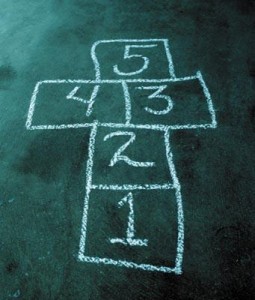 Skip the hard ones
Skip the hard ones
[Note: this post refers to the old SAT. In the new SAT math questions GENERALLY go in order of difficulty by mini-section. Reading and writing questions are in completely random difficulty order.]
Remember how to play hopscotch? You throw your marker on a square and then skip that square when jumping across the board. If you step on the square, you lose a point. Likewise, on the SAT, skipping questions can help you increase your score.
As you know from the previous post of setting the bar to determine your target score, you don’t need to answer all the questions. So it makes the most sense to skip the hard ones because ..well.. they are H A R D.
And even though my students know that, they still get taken in by the cute-little-fuzzy-bunny-like appearance of hard questions. And then they are staggered to discover the hard questions are actually killer vampire bunnies.
So where are the hard questions hanging out? It depends on the section.
Math questions
Math questions pretty much hide at the end of the sections – more specifically, at the end of each mini-section . Math questions are laid out in order of difficulty by mini-section. Which means the section with the grid-in questions has two different mini sections – the multiple-choice questions (1-8) go from easy to medium to hard. Then the difficulty starts over in the grid-in questions (9-18) since that is the start of a new mini-section. (See pages 650-655 in the The Official SAT Study Guide, 2nd edition for an example.)
Here’s a great math graphic showing you exactly what I mean.
Writing questions
Writing questions also mostly follow this pattern – questions go in order of difficulty by mini-section. Sentence Completion questions go from easy to medium to hard (see questions 1-11 on pages 656-657). Then the difficulty level starts over with the Identifying Sentence Errors mini-section (questions 12-29 on pages 658-660). Here’s the exception: the last mini-section (questions 30-35 on pages 660-661) are based on a reading passage – so they follow the order of the passage, not the order of question difficulty.
Here’s the picture of the writing questions.
Critical Reading questions
Critical reading passage-based questions are the exception to the rule. The first page of the Critical Reading section has vocabulary questions. (See page 644.) Those questions do go in order of difficulty. But all the rest of the questions are based on reading passages, and they DO NOT go in order of difficulty. (See pages 645-649.) Instead, they follow the order of the passage. You should still skip hard questions – but you’ll have to guess where they are on the fly. The hard reading passage-based questions don’t hang out together in the same place.
Here’s the visual for the critical reading questions.
Be trepidatious
Got it? Beware the stuff at the end of each mini-section. (Except for questions that are based on reading passages.) Often, you’ll just want to circumvent those hard questions all together.
Want weekly test tips and strategies?
Subscribe to get my latest content by email.